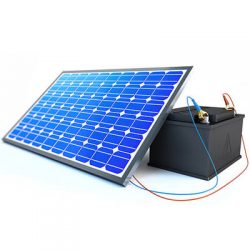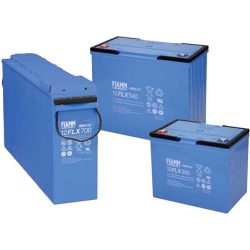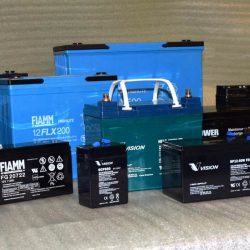Uninterruptible Power Supply (UPS) Batteries, Somerset Power Systems is a stocking distributor for High Rate UPS batteries manufactured by Vision, Ritar, Enersys and other High Rate UPS battery manufacturers. While you can purchase general purpose batteries for less, High Rate batteries designed for use in uninterruptible power supply systems will provide more stable float voltage, more power during loss of commercial power, faster recovery after discharge, fire retardant UL-94 cases, and longer service life compared to general purpose batteries. The right battery in the right application makes all the difference when your critical loads are at risk, don’t chance dropping your critical loads over a few cents difference in cost!
We specialize in Telecom battery configuration and sizing for the correct load profile. We can supply the entire system from the charger, to the racks, including seismic zones 1-4, to the batteries and connection hardware, or any portion of the system. We offer Flooded Cell, AGM/VRLA, OPzV, and Sodium Nickel systems from several established suppliers known for quality and long life.
High Rate Batteries FAQ
- What is the lowest and highest operating temperature range of sealed lead acid batteries?
- The optimal discharging temperature of HR, (High Rate), Series batteries is from -20°C (-4°F) to 50°C (122°F).
- The optimal charging temperature of HR Series batteries is from -20°C (-4°F) to 50°C (122°F).
- The optimal storage temperature of HR Series batteries is from -20°C (-4°F) to 40°C (104°F).
- How are sealed lead acid batteries rated?
- HR Series batteries are rated at their 20hr-rate to 1.75V/cell at 25°C (77°F). HR Series Batteries also carry a WPC, (Watts per Cell), rating, this is the 15 minute rate to 1.67V/cell @ 25°C(77°F)
- For how long sealed lead acid batteries can be stored? How long can sealed lead acid batteries be stored for?
- HR Series batteries can be stored for up to 6 months at 25°C (77°F) and then a freshening charge is recommended. For higher temperatures the time interval will be shorter. For lower temperatures the time interval may be longer. 12 Volt batteries should never be allowed to self- discharge below 12.4 volts, 6 volt batteries should never be allowed to self-discharge below 6.2 volts. A refreshing charge is recommended before the battery in storage self-discharges past these levels.
- How “cycle use” and “standby use” can be defined?
- Cycle Use means direct power source. What cycle use can provide is the power supply to power tools, portable electronic products.
- Cycle Use means the battery is being discharged and recharged regularly. An example would be applications such as electric scooters, material handling or solar lighting.
- Standby Use means back up power. It is commonly used for emergency power to avoid future damage that may be caused by a sudden power outage.
- Standby Use refers to batteries being used for backup power for applications such as Alarm, Emergency Lighting or Uninterruptible Power Systems (UPS). These batteries are being float-charged in a stand-by mode and provide power only when the primary mains power source fails.
- How can you define “over-discharge” and its effect on a battery?
- A battery is over-discharged in case when the final voltage is lower than standard final voltage. Some of the consequences of over-discharging a battery are overuse of active material, degradation of the plate. If you recharge the battery after its over-charging there will be short failures.
- A battery is over discharged in most circumstances when the battery falls below 1.75 volts per cell (VPC) under load, 10.50 volts for a 12 volt battery or 5.25 volts for a 6 volt battery. Some exceptions are permitted for short duration, high rate loads less than 1 hour, (1.67vpc). Battery life expectancy will be reduced and if the battery is over-discharged consistently ad will result in prematurely failure. In all cases, a battery should be recharged immediately after the discharge to prolong life.
- How can I determine if a battery starts to fail?
- What indicates your battery’s fail is a lower performance, low voltage, no recharging, swelled container and acid corrosion.
- All batteries fail eventually. A battery will typically provide less capacity as it begins to age, this is normal. Depending on the application where it is being used and what power is required for that application in may still have a useful a life. End of life is considered to be reached when a battery fails to deliver 80% of its rated capacity.
- What is the life expectancy of sealed lead acid batteries?
- HR Series batteries have an expected life up to 5 years in standby use. XHR Series batteries have an expected life up to 10 years in standby use. All Somerset Power Systems Series batteries have a self-discharge rate of less than 3% of capacity per month.
- What is the container material of sealed lead acid batteries?
- The material that is used for the cases and lids of HR Series batteries is ABS plastic w/ 94-HB & 94-V0 flame retardant case.
- Are Our batteries UL listed?
- All of the HR Series batteries sold by Somerset Power Systems are UL listed and are guaranteed to meet or exceed OEM specifications and performance.
- In what kind of applications High Rate batteries are commonly used?
- HR Series batteries can be used in applications such as:
- Uninterruptible Power Supply (UPS)
- Electric wheelchairs, scooters, bikes
- Electronic apparatus and equipment
- Alarm and security systems
- Emergency first responder equipment
- Emergency lighting
- Medical devices
- Electric carts
- Telecom equipment Switchgear
- Solar power systems
- HR Series batteries can be used in applications such as:






